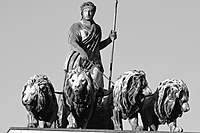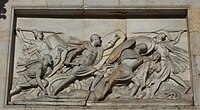Victory gate
The Siegestor is a classical triumphal arch in Munich , which was built from 1843 to 1850 according to plans by Friedrich von Gärtner . It forms the northern end of Ludwigstrasse . It is the architectural and urban counterpart to the Feldherrnhalle. Both are symbols of the victory over Napoleon I's France and the temporary reign of terror associated with it for Europe, which involved the Kingdom of Bavaria in five wars.
Location and dimensions
The Siegestor is about one kilometer north of the Feldherrnhalle and separates Ludwigstrasse , which ends there, from Leopoldstrasse , which begins here. The Siegestor marks the border between the two Munich districts of Maxvorstadt and Schwabing . The 24-meter-wide, 21-meter-high and twelve-meter-deep monument is crowned by the 22-ton quadriga. In the middle is a six-meter-tall Bavaria that steers a carriage drawn by four lions (horses were originally intended). The address of the Siegestor is Leopoldstrasse 1.
history
In 1840 Ludwig I commissioned his architect Friedrich von Gärtner to plan a triumphal arch modeled on the Arch of Constantine in Rome as the end of his boulevard, Ludwigstrasse. This triumphal arch should be dedicated to the Bavarian Army and thus correspond directly with the Feldherrnhalle, with which its boulevard begins.
The Siegestor, like the Feldherrnhalle, was built from Kelheim limestone from 1843 to 1850. After Friedrich von Gärtner's death in 1847, his student Eduard Metzger took over the work. On October 15, 1850, King Maximilian II handed over the Siegestor to the city of Munich in the name of his abdicated father. Ludwig - he had been forced into retirement two years earlier because of the Montez affair - demonstratively stayed away from the inauguration.
When Bavarian troops marched through the ceremoniously decorated gate on July 16, 1871 after their victories in the Franco-German War, it was only consecrated according to its name.
Badly damaged in the air raids on Munich in World War II , it was rebuilt in 1958 under the direction of Josef Wiedemann - deliberately simplified on the south side. It had previously been declared as “fascist” and then as a “threat to public safety” and was to be demolished in July 1954, which the State Office for Monument Preservation prevented. In 1972 the quadriga restored by Elmar Dietz could be erected on the Siegestor.
Ferdinand von Miller with his sons Fritz and Ferdinand loading the lion for the Great Exhibition in London (1851)
Architecture and program
With the Siegestor, Friedrich von Gärtner succeeded in creating more than a copy of the Arch of Constantine . The columns, which are placed on high pedestals, emphasize the clear vertical structure. The massive entablature presses like a heavy load onto the three harmoniously rhythmic arches. This gives the triumphal arch the architectural power to absorb the procession of the victory gate and to direct it into the fields and meadows that still dominated in 1852. The enthroned floating quadriga hovers over the Siegestor and emphasizes its central axis. At the same time, the Bavaria drives on the Quadriga out of town into the fields and meadows, facing “The Bavarian Army” , as the inscription on the north side reveals. Johann von Halbig supplied the colossal four-horse carriage from Löwen to the one based on Johann Martin von Wagner's design for Bavaria, which Friedrich Brugger modeled.
The motifs of the reliefs show battle scenes that underline the strength and will of the Bavarian army. The medallions, on the other hand, represent allegories of the Bavarian circles of that time:
- Districts of Upper and Lower Bavaria : Alpine cattle breeding;
- Districts of Upper and Middle Franconia : handicrafts and cattle breeding;
- District of Lower Franconia : wine, grain growing and shipping;
- Rheinpfalz district : wine and fishing;
- Upper Palatinate district : hammer mill;
- District of Swabia : weaving.
After the Second World War, under the impression of the destruction and other consequences such as displacement and war guilt, the architects Otto Roth and Josef Wiedemann deliberately restored the gate in a simplified manner and added an additional inscription on the south side, written by Hanns Braun and designed by Franz Hart : "Consecrated to victory - destroyed by war - admonishing to peace". This gives the Siegestor a new symbolic meaning: War not only brings victory, but also suffering and destruction - it even destroys symbols of victory. So the solution can only be peace .
The Siegestor is thus also a peace memorial , similar to the tower of the Kaiser Wilhelm Memorial Church in Berlin.
Art at the Siegestor
From February 17, 2018, there were two five-meter-wide and two-and-a-half-meter high “Love-Hate” ambigrams made of patinated steel at the Siegestor for five months . It was an art installation by Mia Florentine Weiss in the run-up to the Munich Faust Festival 2018 .
literature
- Klaus Gallas : Munich. From the Guelph foundation of Henry the Lion to the present: art, culture, history (= DuMont documents: DuMont art travel guide ). DuMont, Cologne 1979, ISBN 3-7701-1094-3 .
- Thomas Weidner: The Siegestor and its fragments . With contributions by Richard Bauer and Hans Senninger. Buchendorfer, Munich 1996, ISBN 3-927984-52-3 (for the exhibition Das Siegestor , Münchner Stadtmuseum , May 24, 1996 to June 30, 1996).
Web links
- muenchen.de: Siegestor
Individual evidence
- ↑ Karl Forster: Munich - SPD laments the deterioration of Leopoldstrasse. Accessed December 1, 2019 .
- ^ Eduard Metzger . In: Hans Vollmer (Hrsg.): General lexicon of fine artists from antiquity to the present . Founded by Ulrich Thieme and Felix Becker . tape 24 : Mandere – Möhl . EA Seemann, Leipzig 1930, p. 446 .
- ^ Deutsches Kunstblatt . I (1850), No. 46 of November 18, 1850, p. 361 ff.
- ↑ "Love Hate" sculptures set up at the Siegestor. muenchen.de, accessed on May 10, 2018 .
- ^ Greetings from steel. merkur.de, March 13, 2018, accessed on May 10, 2018 .
- ↑ Evelyn Vogel: Through hell to heaven . In: Süddeutsche Zeitung . February 18, 2018 ( sueddeutsche.de [accessed May 10, 2018]).
Coordinates: 48 ° 9 ′ 8 ″ N , 11 ° 34 ′ 55 ″ E








